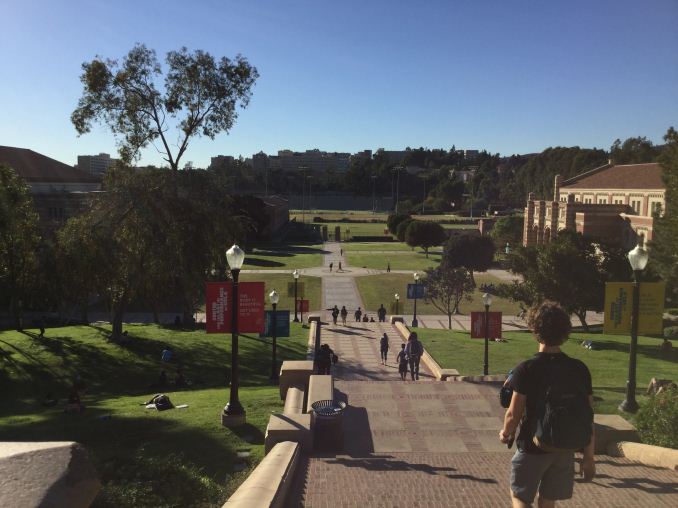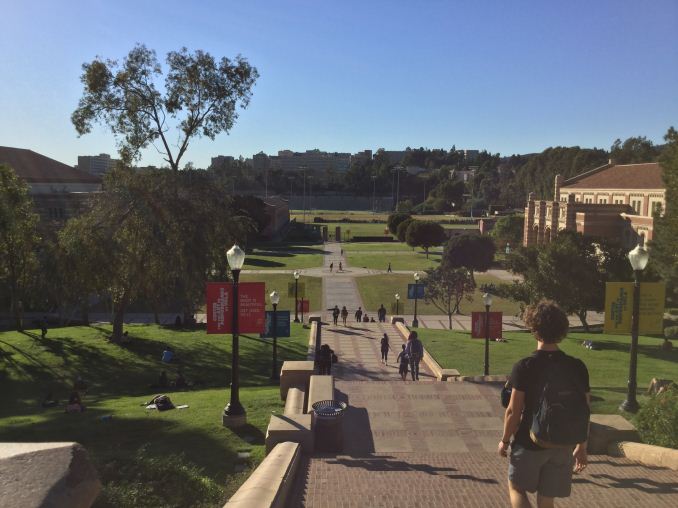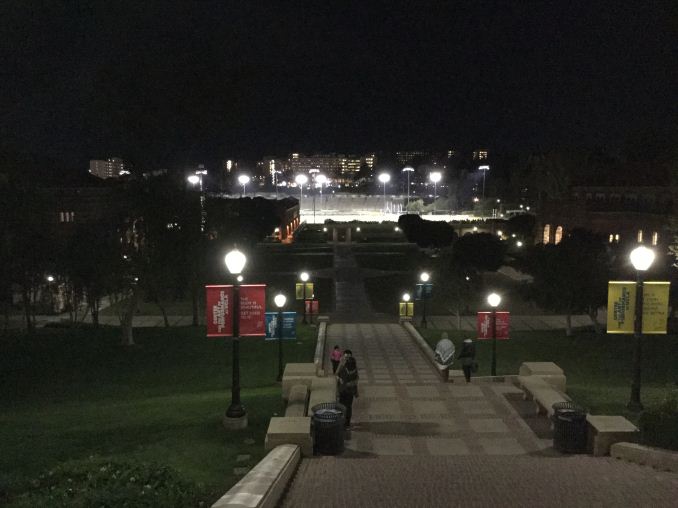The Apple iPad Air 2 Review
by Joshua Ho on November 7, 2014 9:30 AM EST- Posted in
- Tablets
- Apple
- Mobile
- iOS
- ipad Air 2
Camera
For better or worse, the camera on a tablet has become increasingly important. While there was a time when the cameras on tablets were solely used for video calls and similar functions where quality was of relatively low importance, there’s been a clear shift in the other direction. While I don’t think anyone is going to use their tablet as a primary camera, there is a level of convenience that comes with it. I’ve definitely found it to be rather intensely uncomfortable to use a tablet as a camera at all as it’s the furthest thing from inconspicuous. This brings us to the iPad Air 2, which brings the first notable camera change to the iPad line since the iPad 3, as seen below.
| Rear Facing Camera Comparison | |||||||
| Sensor | Resolution | Aperture | Focal Length | ||||
| Apple iPad Air 2 | 8 MP | 3264 x 2448 | f/2.4 | 3.3mm | |||
| Apple iPad Air | 5MP | 2592 x 1936 | f/2.4 | 3.3mm | |||
| Apple iPad 4 | 5MP | 2592 x 1936 | f/2.4 | 4.3mm | |||
| Apple iPad 3 | 5MP | 2592 x 1936 | f/2.4 | 4.3mm | |||
| Apple iPad 2 | 0.7MP | 960 x 720 | f/2.4 | 2.0mm | |||
| Apple iPad mini | 5MP | 2592 x 1936 | f/2.4 | 3.3mm | |||
While the iPad Air 2’s camera does have an eight megapixel output image, it’s important to distinguish this from the iPhone line as the sensor is noticeably smaller than what we see on something like the iPhone 6 and 6 Plus. Instead of 1.5 micron pixels, this gives us 1.1 micron pixels. In addition, the camera lacks PDAF, so focus times will definitely take a fall as a result. On the flip side, this also means no camera hump on the back.
While focus times are one thing, the difference in pixel sensitivity is likely to be the biggest difference. In casual testing, the ISO of the rear-facing camera goes between 25 and 800 ISO, and the front-facing 1.3MP camera will vary between 50 and 2000 ISO. As the tablet lacks optical stabilization, Apple has capped exposure time to a maximum of 1/15 seconds similar to what we see with the iPhone 6.
As one might guess, this difference in sensitivity doesn’t actually make for a significant difference in daytime. While 1.1 micron pixels are relatively small, daytime resolution isn’t all that far off from the iPhone 6. The extremely low sensor gain means that the impact of lower pixel sensitivity isn’t all that significant. It’s clear that the A8’s ISP does a good job of preserving detail while removing noise as we don’t see loss of detail in low contrast areas and noise in general is hard to see outside of the sky.
HDR is also quite good as one might expect, with no perceivable halos or ghosting effects from moving objects.
Unfortunately, in low light we see the weakness of the smaller pixel sizes as a significant amount of noise creeps in. This is especially obvious in preview as noise reduction doesn’t seem to be running at that point. Given the amount of noise in the preview, it’s still quite impressive how Apple manages to make the best of a system that isn’t really designed for low light photography. While a great deal of low-contrast detail is gone, there is a great deal of detail preserved and such images definitely good enough to put online if necessary. I don’t see any major color noise in the image, and luminance noise strikes a good balance between excessive blurring and obvious speckle.
In video, we see a similar pattern. On the whole, the iPad Air 2 benefits from the shared ISP from the iPhone 6’s A8 SoC as the EIS solution is surprisingly effective at suppressing high-frequency shaking. In daytime, detail in video is surprisingly good and quite close to what we see with the iPhone 6 line of devices. The one noticeable weakness is that due to the lack of PDAF, it’s necessary to stop and tap to focus on specific objects to maintain detail. There is auto-exposure, but video performance overall is a bit weaker than what one would get from the best smartphone cameras available. We see the same 17 Mbps bitrate encoded with H.264 high profile here as on the iPhone 6.
The iPad Air 2 also has a slow motion mode, which does 120 FPS at around 31 Mbps encoded with H.264 high profile and plays back at 30 FPS. The resolution is 720p, which is in line with other iOS devices for slow motion.
Once again, in low light we see the weakness in the smaller sensor. There’s a great deal of noise visible throughout the video, although there is an acceptable amount of detail and frame rate remains relatively high.
Overall, it’s hard to really find fault with the camera. While the smaller sensor size and lack of phase-detect focus does make for worse images, the camera can actually take good photos in daytime and usable photos in low light. Video follows a similar pattern as well. As said before, this camera is unlikely to be of any value as a primary camera due to the tablet formfactor. However, for applications that need a camera this should be quite serviceable.































226 Comments
View All Comments
DosOldie - Sunday, November 9, 2014 - link
I still have an iPad 2 and I do not plan on upgrading my iPad until there is add on space. Put in a usable SD slot and I' ll upgrade. Adding & deleting apps will not change w a new iPad w the same amt of space.ws3 - Wednesday, November 12, 2014 - link
So you will never be upgrading...tralalalalalala40 - Thursday, November 13, 2014 - link
See the iStick... You see. everything is going wireless. They have wireless HDs from toshiba that are for the iPad now. You don't need a random dust collecting/battery dwindling port to get done what you want to get done.sdagley - Monday, November 10, 2014 - link
The line "I’m not necessarily sold on TouchID on a tablet as an ergonomic ideal as the sheer width of the device makes it a bit harder than usual to properly place my finger for scanning" in the Final Words section doesn't make sense. The TouchID sensor works with multiple fingers at any any orientation which makes it easy to use no matter how you're holding it. This review makes it sound like Apple uses the old style vertical swipe sensor like the Galaxy S5 usesLgFriess - Monday, November 10, 2014 - link
Just picked up an Air 2 over the weekend. I'm no Apple fan boy (PC gamer, Note 3 phone and don't think I'll ever go back to an iphone, and I generally despise itunes) , I just wanted what I thought would work best for me. After agonizing for months over every tablet out there including the Nexus 9, I just liked the Air 2.The cons (since that's what everybody seems interested in);
1. It's almost too thin. It feels delicate to me. I'd much rather have a bit thicker tablet with a more substantial feel. Stop with the thin thin thinner crap. Of course I have a case on the way but still.
2. The vibration. Yep it's definitely there. However, I can't think of any situation that this would bother me in the least bit. I wouldn't have thought to mention it but I saw so many comments here saying it's worse then ebola. There is no way somebodies fingers are going numb when holding it. People are starting to make up things to enforce their argument. The vibration certainly goes back to problem 1. Too thin, too light, too delicate in the hand.
3. Speakers. Not that I'm expecting anything great on a tablet but I sure like the thought of the Nexus front facing speakers. It's just a better solution. The ipad speakers aren't bad at all. They're just typical tablet speakers.
All in all, it's been a great addition. Fast, smooth, great apps (just tried Hearthstone for the first time, and as a PC gamer, I'd say it makes a great tablet game which I generally can't stand), display is gorgeous, battery life is longer then expected though gaming will eat it up quickly. The fingerprint ID thing IS nice, which surprises me as I wouldn't have thought I would care.
Very happy with my purchase.
LgFriess - Monday, November 10, 2014 - link
One other thing. There is absolutely NO distortion just holding the tablet. Another instance of over dramatization. I've put a little pressure into the back and didn't notice any distortion in that case either, but as I've said above, I do feel it's too thin/delicate and I'm afraid I'll damage it if I were to squeeze it too much. By "too much" I mean actively trying to bend it to see if the screen will distort, but not under normal use.tralalalalalala40 - Thursday, November 13, 2014 - link
When I pile-drive my LCD monitors at work they distort so I took them back.yhselp - Monday, November 10, 2014 - link
It's worth mentioning that this is the first handheld device (apart from full-fledged Windows tablets) truly close to last-gen gaming consoles in terms of performance - 25.6 GB/s memory bandwidth and a powerful triple-core CPU. It'd be interesting to see how the 1.5 GHz enhanced Cyclone stacks against the 3.2 GHz PowerPC in the Xbox 360.spammy39 - Tuesday, November 11, 2014 - link
Is there any reason why Anandtech does not include the Surface Pro 3 on the benchmark list?Fairshare - Wednesday, November 12, 2014 - link
Do you see any Intel Core based tablets here? The Surface Pro 3 is a PC that just happens to be a tablet so it's not really comparable in terms of performance. You might compare other statistics such as battery, display etc. but it's otherwise a completely different animal.